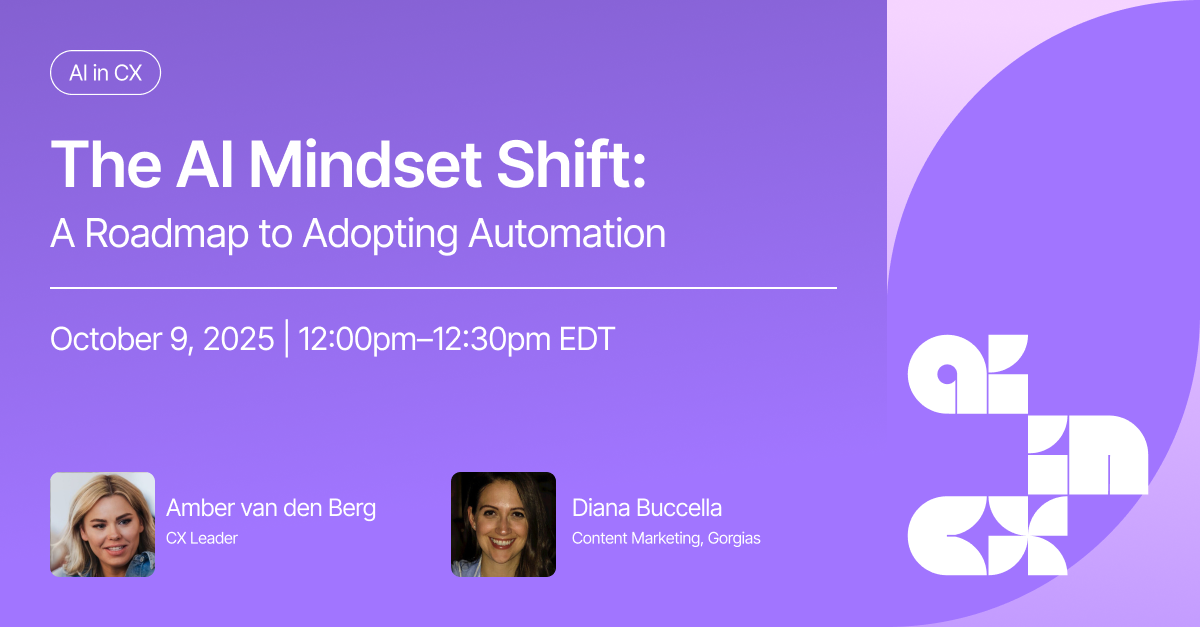The only CX playbook you need before Black Friday
Read and loved by 10,000+ people
Hi Team,
I didn’t go to school for this. Turns out, CX isn’t a real major. And even if it were, I doubt I would’ve lasted more than a week; I dropped out of high school. 🙃
I got into CX the way most of us do. By sitting in front of a support inbox getting yelled at by strangers, and somehow deciding this could be a career. I had no real background in anything other than trying to keep people from lighting my day on fire. I learned fast. Mostly because I had to.
I questioned everything. Why are we outsourcing this? Why do we score agents like it’s middle school? Why is CX treated like a cost instead of something that drives growth? I didn’t question my Sweetgreen order, but that was about the only thing.
Eventually, I built out the CX function at OLIPOP. Then moved to Jones Road. People started reaching out. A lot of them. I was getting 30 to 40 messages a week asking for advice. Not in a “how do I automate tickets” way. More like “how do I do this well without going insane?”
Instead of trying to reply to everyone (my introvert NIGHTMARE), I wrote CX Unlocked (link at the end of the newsie). It was a brain dump of what actually works. It’s the playbook I wish I had when I was in the inbox 12 hours a day.
It’s now passed 10,000 downloads. And I’ve gotten more thoughtful feedback on it than anything else I’ve written. CX’ers finally feeling seen.
So here’s the abridged version. Updated where it needs to be. Still grounded. Still useful.
This week’s newsie is brought to you by Gorgias!
Join them for AI in CX — their new series exploring how real leaders are using automation to improve their customer experiences. We’ll cover everything from automation roadmaps to training and optimizing AI Agents.
Each session features a live talk from a CX leader who’s been in your shoes. They’ll share their unfiltered experience on everything from onboarding an AI Agent to reporting on new automation KPIs.
In Episode One, Amber van den Berg will walk you through:
Her journey from an AI skeptic to a self-proclaimed “Automation Wizard”
The AI Roadmap: from hesitation → implementation → automation
The first steps you should take to kickstart your AI in CX strategy
Bonus: Can’t make it live? Register anyway and you’ll receive the recording + a practical framework to apply to your business.
Start with the people
Your first few hires shape everything. They are the tone, the culture, and they decide how every future hire behaves.
If the first person in the inbox is cold, robotic, or doesn’t care, your brand inherits that. If they’re warm, fast, thoughtful, and know when to bend the rules, you get something worth building on.
Taking an extra step here, if they are not in the weeds, shirk responsibility, and are afraid to get their hands dirty, that too will impact your CX culture.
At Jones Road, we hired makeup artists. They understood tone and knew how to help people feel confident. At OLIPOP, we hired people who already loved the product. We were less concerned about hiring “CX experts.” We more so wanted people who just gave a sh!t.
Shortcut: if you’d trust them to watch your kids or de-escalate a very angry passenger on a full flight, hire them.
Set your rules before someone else does
If you don’t define how CX works at your company, Finance, Legal, or Ops will do it for you. And they will not be thinking about the customer when they do it.
It always starts the same way. Things are going fine. Then someone from another team drops a new rule. A refund cap. A new macro. A line you’re not allowed to cross. Suddenly, your team is defending policies they didn’t write and don’t believe in.
At OLIPOP, we made one slide with eight values. Simple stuff. Fix the issue. Make it easy to get help. Apologize for the situation the customer is in, even if it’s not our fault. Support each other. Be honest. Don’t waste time.
At Jones Road, we took it further. Real scenarios. Judgment calls. Grey areas. What to do when someone is being rude but has a point. What to say when a customer is wrong, but we’re still going to help anyway.
Fix the boring stuff first
Everybody wants to be the brand that sends surprise gifts or handwritten notes. That’s great. But not if your return process is confusing or your emails don’t load on mobile.
Fix the stuff that breaks trust first. Then you can start thinking about magic.
Like Dan & Chip Heath call it in “The Power Of Moments,” fill the valleys before you start trying to create peaks.
Fast responses. Clear policies. Solid automation. A tone that sounds like a person wrote it. That’s your actual CX foundation. Everything else is a bonus.
Don’t put glitter on a broken experience. Customers can tell.
Refunds are protection
Refunds aren’t always where you lose money. They’re often where you save it.
If you have a customer who has purchased 10 times with you and has an issue with an order, and you are “following rules” so you won’t treat them like the VIP they are, that’s a fast-track way to lose them.
If your team has to open a ticket to get approval to solve a ticket, you’ve already lost.
“Eli, this is obvious.”
LMAO, no, it isn’t. 95% of brands I’ve seen have rigid rules and give CX zero ability to make cognitive decisions to improve LTV and brand.
Oh, and the brands I’ve been most loyal to have screwed me the most the one single time I’ve had an issue to report…
Tag or stay blind
If you’re not tagging tickets, you’re not learning anything.
At Jones Road, we tagged shade match requests. At OLIPOP, we tagged Gopuff complaints, delivery misses, flavor issues, and product confusion.
Tags helped us prove when something was actually broken. They helped us make the case for updating flows or policies, or shipping courier choices. They helped us push insights to the teams who could fix what we couldn’t.
It’s not enough to collect insights. You have to move them to where they matter.
Your macros are probably bad
Most macros were written by someone who didn’t want to write macros.
That’s why they sound stiff, weird, and defensive. Or worse, they sound like the customer is being talked down to like the condescending representative at the gate check explaining why your small carry-on can’t indeed be “CARRIED ON.”
We rewrote every macro to feel like a starting point from a human, not a script. We left space to add a name, a sentence of context, and a kind sign-off.
The best macros are the ones your team actually wants to use. If they’re constantly rewriting yours, it’s not because they’re wrong. It’s because the macro is.
Shade match changed everything
It started simple. A customer would email and ask what shade of foundation to buy. A rep would respond. Done.
Then we tagged it.
When we looked at the data, shade-matched customers had higher repeat rates. More cross-category purchases. Fewer complaints. Better retention.
We trained our reps. Built flows. Pushed it harder.
Customers who were shade-matched had 111 percent higher LTV after six months. No weird discounts or gimmicks. Instead, helpful advice from someone who understood the product.
Support was the reason people came back.
Automate with an exit
Automation is great until it becomes a wall.
Let people update addresses, cancel orders, check tracking. That’s helpful.
But when someone’s frustrated or confused, they need to reach a person. If your automation makes that difficult, they’ll remember that more than anything else you did.
And here’s the part I still can’t wrap my head around.
I’ve seen a slew of brand operators complain this week on X about how Shopify support has now added AI and how hard it is to get to a human.
But then I see them all celebrating how much of their tickets are deflected by AI, knowing well that their AI is not 10x better than whatever the godfather is using.
Now, let’s be clear, I am a big proponent of using AI smartly, but cognitive dissonance is a hell of a drug. 😵
We hate it when it happens to us. Then we turn around and brag about our own automation numbers like we invented customer joy.
“Look at our chatbot. It deflected 78 percent of tickets.”
Cool. How many of those were people who gave up?
Automation should save time and get people to the right place. If it just hides your team behind a wall, it’s not working.
Burnout doesn’t announce itself
The best CX people burn out quietly. They don’t complain. They just get a little slower. A little colder. They stop adding the extra sentence. They stop writing like themselves.
These are the same people you rely on to save the day. The ones who always take the tough tickets. The ones who notice something off before it becomes a crisis.
At OLIPOP, we gave everyone a monthly day off. At Jones Road, we pushed rest when it was earned, not just when it was scheduled.
You don’t need a mental health policy. You just need to notice when someone’s carrying more than they should and push them to actually take the “unlimited PTO” they are collecting.
Good support is emotional labor. You either take care of the people doing it, or you lose them.
The full version is still live
This version covers the basics. The full guide has everything else: how we hired, how we wrote team values, how we tracked emotional labor, and how we pitched CX as a growth lever to the rest of the exec team.
That’s it for this week!
Any topics you'd like to see me cover in the future?
Just shoot me a DM or an email!
Cheers,
Eli 💛
P.S. If you want to figure out how to get your brand to rank high in LLMs and show up in ChatGPT, Gemini, and more… check this out.







